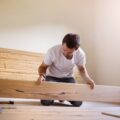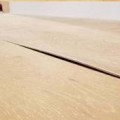5 Common Wood Flooring Installation Mistakes
Wood floors are a great investment for many homeowners. They look stylish, feel great underfoot, and can add to the value of your home. While you can add many types of wood floors to your home with a DIY installation, homeowners can succumb to many pitfalls during the process. Learn more about the five most common wood flooring installation mistakes and find out how you can avoid them when adding this flooring style to your home.

Wood Flooring Installation Mistakes to Avoid
1. Not Preparing the Subfloor
The condition of your subfloor will have a direct impact on the quality of your hardwood floors. When the subfloor is not properly prepared before installation, it can lead to a number of problems, such as loose boards and loud creaking noises. Over time, you may need to replace select wood planks or deal with cracked or warped floors as a result of these issues.
Don’t rush the process when working on your subfloors before installing the new wood flooring. The better the condition of your subfloors, the longer your wood floors will remain in good condition over the years to come.
2. Forgetting to Check Moisture Levels
Humidity has a direct impact on wood flooring. When conditions are dry, the wood planks contract. When moisture is present, the wood flooring starts to expand. When the boards are installed at either of these two extremes, you’re more likely to see issues develop over time.
For example, wood floors installed during a dry winter will be at their most contracted state, and when the weather heats up and becomes more humid, the boards expand and can begin to crack due to the increased pressure. However, wood floors installed when the weather is quite humid and warm are already expanded. When the weather becomes cool and dry during the winter, the boards contract and homeowners notice gaps between the boards.
If you live in a climate that experiences cold, dry winters and hot, humid summers, take moisture levels into account before you install wood flooring. Those who live in milder climates may not experience these issues.
3. Creating a Lazy Layout
Even if it appears that your home has right angles at every corner, your rooms are not likely to be perfectly square. When you hastily start installing wood floors, you may find out that the planks look odd in certain places or need to be cut at strange angles to fit.
Since wood planks create long lines that run across your floors, a poor layout will be particularly noticeable. You want to produce highly accurate measurements of the floors you’ll be covering before you get started on installation. By planning out all your work ahead of time, you can spot any potential problems before it’s too late to undo your work.
4. Going the Bad Racking Route
With wood flooring, “racking” simply means planning the order in which the boards will be installed. Racking a hardwood floor makes the installation process go smoothly while also ensuring an attractive look once everything is in place. When you don’t rack your wood planks or you rush the process, you can end up with a floor that has too many joints clustered together in one spot or an odd placement of different lengths, grain patterns, or wood tones.
5. Not Nailing Enough
It may seem that your boards are securely in place as you go through the installation process. However, you’ll want to carefully install each plank with enough fasteners to prevent loose boards, creaking, and other issues in the future. Don’t rely on snugly installed planks to hold enough of the other pieces in place. In addition, avoid rushing through the project since haste may make you more likely to forget to nail down each plank properly.
How Can You Avoid These Common Wood Flooring Installation Mistakes?
The flooring mistakes above may be the most common, but fortunately, they are also easy to avoid. Use the following tips to make sure your wood flooring is installed properly.
- Let Wood Floors Acclimate to the Environment: Allow the wood floors to sit in your home for several days to acclimate before beginning the installation process. Avoid issues with moisture levels in the air by installing your wood floors in the spring or fall when moisture levels are in between the two extremes of dry and humid conditions.
- Prepare Subfloors Properly: Your subfloors should be clean, dry, and flat before installing wood flooring. You should also make sure you’re not installing your wood floors on an inappropriate subfloor, such as particleboard.
- Measure Carefully: Use accurate measurements to help lay the flooring in a way that looks best in your home. Avoid awkward positioning, such as boards that need to be cut very narrow to fit in front of a doorway or staircase.
- Lay Out Everything: Use the racking process as a chance to lay out your floors and make sure you like the look before you get started with the installation. Move planks around as needed to get a nicer look, especially in highly visible areas such as entryways, stair landings, or in front of a fireplace.
- Include Enough Fasteners: You should have at least two fasteners per plank. If the planks are wide, you may need to include more fasteners.
- Hire a Pro: If you’re feeling unsure about this type of DIY project, hire a professional to install your wood flooring instead. Although having pros, such as BuildDirect PROs, complete your wood flooring installation will cost more, you’ll avoid the costs of repairs that may be needed down the road if you fail to install them properly yourself. Hiring a pro is also a good idea for site-finished flooring, nail-down flooring, and unusual room configurations.
Now that you know which common wood flooring installation mistakes to watch out for, you should be able to more easily complete this DIY home improvement project successfully. Laying wood floors takes much work, so if you feel overwhelmed by the task, don’t hesitate to get professionals to help out with the job.






